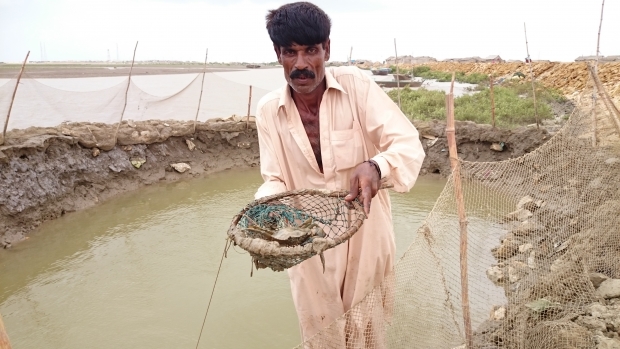Grants :: Small Grant Facilities :: Alternative livelihood of 8 Household fishermen through community managed aquaculture mud crab farming in four villages of UC Keti Bunder
Alternative livelihood of 8 Household fishermen through community managed aquaculture mud crab farming in four villages of UC Keti Bunder

Crab Fattening, Keti Bundar © MFF/DDS
Objectives
To Provide alternative livelihood aquaculture (Juvenile Mud crab) farming to 8 poor fisher community (one male and one female in same Household) living in four villages of UC Keti Bunder
Background
The marine resources in villages of UC Keti Bunder like other coastal villages in creek terrain of District Thatta are increasingly eroding the livelihood options. Small-scale coastal aquaculture has successfully been introduced throughout coastal belt and has the potential to be developed also in this village. Aquaculture initiatives have already started within the coastal belt and the interest among coastal communities seems high. Crab aquaculture (Scylla serrata) is one such activity that is developing within the coastal belt of Sindh province and the favorable market situation, both local and globally, may drive this development further. However, for developing any aquaculture activity in a sustainable way there is a need to introduce it at household levels with demonstration, train local fisherman communities in mud crab farming and its proper marketing.
The fisheries sector in Pakistan makes a significant contribution to the national economy, contributing about one percent to GDP and providing jobs to about one percent of the country's labor force.
There are a large number of fishermen’s villages all along Pakistan’s coastline where fishing is primary source of earnings for centuries Sindh is bestowed with a large coastal belt that supports the livelihoods of thousands mainly through fishing related activities.
Acute water shortage in the region, the intrusion of seawater, and the consequent loss of agricultural land due to climate change has had a significant impact on local fishing communities which depended on fisheries for their livelihood. The loss of this source of income has increased pressure on coastal resources, resulting in unsustainable fishing practices (such as using fine mesh nets) and over-exploitation of mangroves for grazing and fuel wood.
Recent studies have identified a number of potential alternative livelihood options for the disadvantaged groups, one of the options is mud crab Scylla ,that has been gaining popularity among the coastal community of district Thatta but poor fisherman communities are unable to go for aquaculture of mud crabbing due lack of technical capacity and financial resources as input for aquaculture farms and proper market value chain knowledge resulting deterioration in economic situation of communities.
Target beneficiaries
Fishing communities of four villages in Union Council Keti Bunder
Outputs
- 16 Households ultra -poor beneficiaries identified in four villages of UC Keti Bunder and mobilized for project benefits
- 8 small scale community managed mud crab farms constructed in four villages of Keti Bunder ( Two farms in each village)
- 16 project beneficiaries ( 50% female) trained in mud crab aquaculture and its marketing
- Documentation and dissemination of lessons learnt
Accomplishments and challenges
- Eight poor supported in establishment of household based crab fattening ponds in four villages.
- 16 beneficiaries trained in crab pond management through Sindh Fisheries Department.
- Guidelines on mud crab pond establishment developed in local language and disseminated among the local fisherfolks.
- Cumulatively, all the beneficiaries have earned PKR 766,110/- from the sale 2-3 cycles of fattened crabs.
- The frequent high tides and muddy conditions resulted in difficulties in construction of ponds and affected the project cost.
Contributions to cross-cutting themes
- The project facilitated in adoption of modern techniques and knowledge by coastal communities; therefore, has contributed to the resilience of beneficiary households to climate change related disasters.
-
Women constituted marginalized group in the area. The project ensured gender equity through pairing of women with male beneficiaries.
Lessons Learned
- Coastal belt is naturally rich for fattening of mud crab since due to very good economic returns; thus, it will generate good income benefits for the poor families.
- The practice of crab fattening is spreading widely in the area, resulting in additional income to the fishing households. The high demand has resulted in increase in their price of immature crabs.
- Fishermen now tend to fatten the crabs in ponds rather than selling immature crabs to earn their better values.
- Fisheries department may explore possibilities of establishment of a hatchery for production of juvenile mud crabs to reduce dependence on wild stocks which will benefit communities, ecosystem and commercial ventures.
- During MLE visits it was found that some beneficiaries have stone pitched their ponds which were damaged by high sea waves, indicating ownership of the intervention by beneficiary households. Crab stock kept for fattening in the ponds was also observed.
Project Facts
Country
Location
Keti Bunder, Sindh, Pakistan
Topic
Duration
15th Dec 2014 to 15th Jun 2015
MFF Grant Amount
PKR 998,160
Co-financing Partner
Sindh Fisheries Department
Implementing Partner
Sain Mansoor Dino Dahri
Executive Director
Address: A-73, Al-Rehman Cottages opposite HONDA Palace,
Bi-pass, Hyderabad-71000, Sindh Pakistan
Tel: 0092-22-3667141 / Cell: 0092-300-3094643/ 0092-333-2682088
E-mail: dds@dds.org.pk , dhartee.org@gmail.com ,Website: www.dds.org.pk